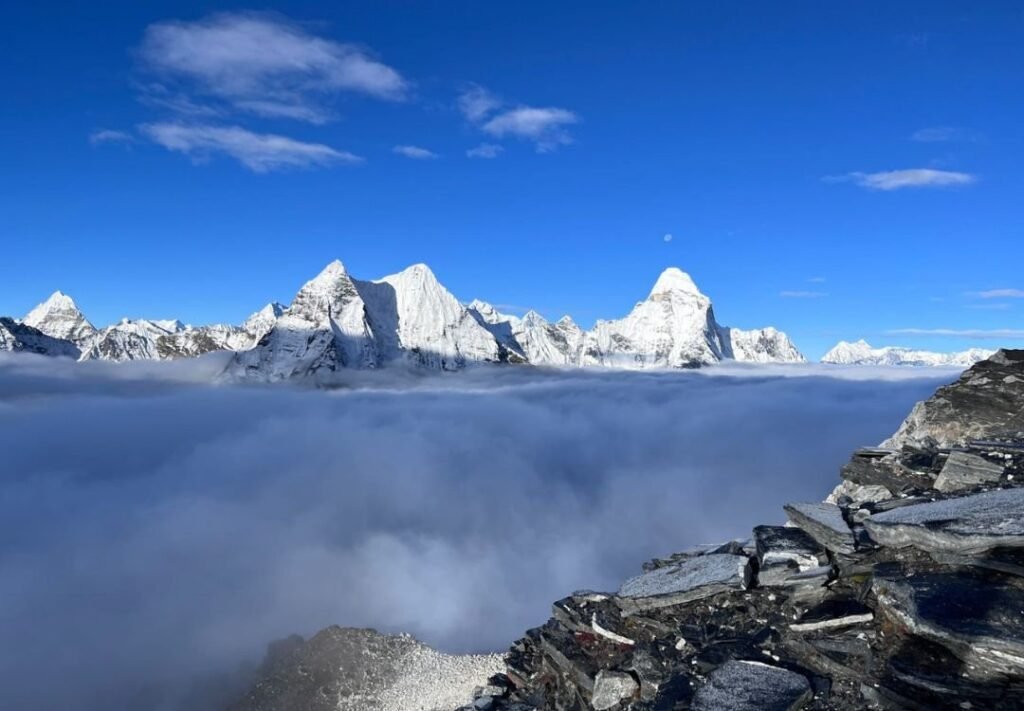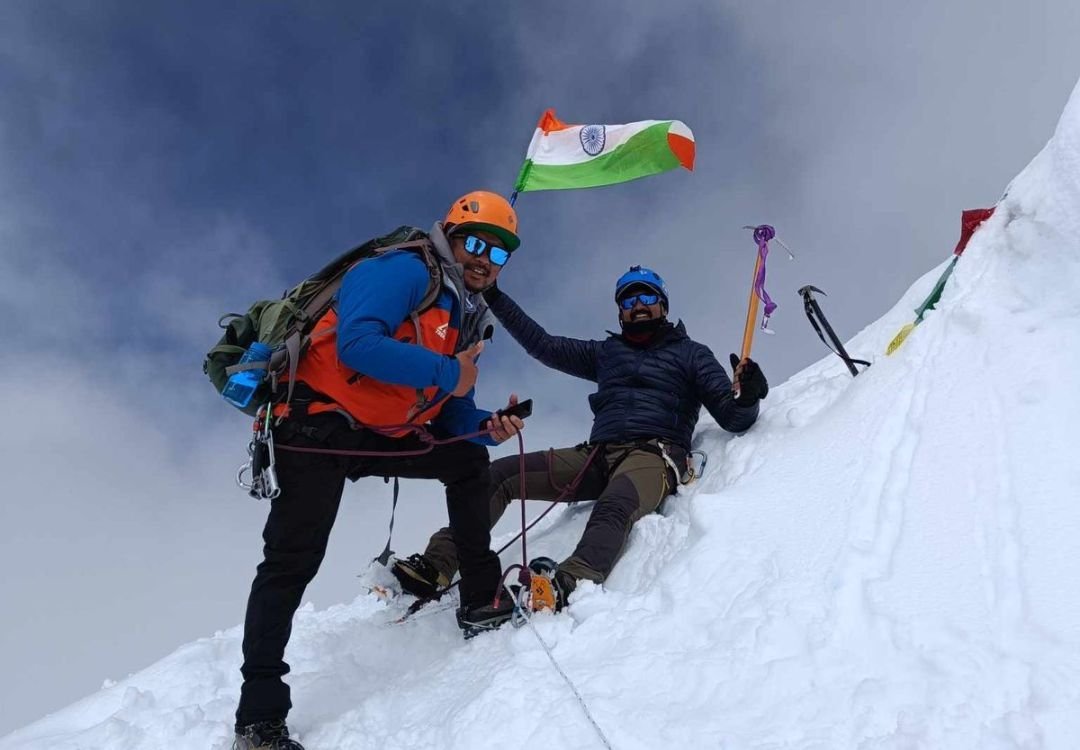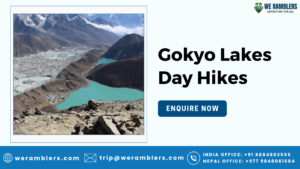Rescue During Island Peak Climb: What Every Trekker Must Know Before the Summit Push
The Island Peak Climb, also known locally as Imja Tse, stands tall at 6,189 meters and is one of the most accessible trekking peaks in the Himalayas. Despite being classified as a “trekking peak,” it is far from easy. Island Peak draws mountaineering enthusiasts from across the globe who seek the thrill of conquering an actual Himalayan summit. The journey begins in the iconic Khumbu region, passing through rugged valleys, steep ascents, icy glaciers, and dramatic landscapes.
However, while the experience is breathtaking, so are the risks. The thin air, freezing temperatures, and extreme altitude bring the dangers of altitude sickness, exhaustion, and sudden weather changes. These factors turn even a small issue into a life-threatening emergency. That’s why understanding how rescue during Island Peak Climb works is essential for every climber’s safety and peace of mind. Awareness can make the difference between a well-managed evacuation and a disastrous delay.
Emergencies in the Death Zone: What Can Go Wrong on Island Peak
Trekking and climbing at altitudes above 5,000 meters expose the human body to conditions it was never designed to handle for extended periods. The final ascent toward Island Peak demands ice axe use, crampons, rope work, and glacier crossings, all under low-oxygen conditions. Emergencies, while not guaranteed, are not rare either.
One of the most common issues is Acute Mountain Sickness (AMS), which typically starts above 2,500–3,000 meters. As you ascend closer to Island Peak Base Camp or High Camp, the risks of AMS transforming into HAPE (fluid in the lungs) or HACE (brain swelling due to altitude) increase rapidly. These situations require immediate altitude sickness rescue in the Everest region to prevent life-threatening outcomes.
Injuries on glacial terrain are another risk. A misstep with crampons or a fall into a crevasse could result in fractures or deep lacerations. Add to that the cold, which increases the chances of frostbite or hypothermia, and the need for rescue from the Island Peak region becomes a critical consideration for any team. In extreme cases, climbers may also suffer from high-altitude exhaustion, where the body simply shuts down due to lack of oxygen and nutrition.
Helicopter Rescue from Island Peak and How It Works
In situations where ground evacuation isn’t possible, helicopter rescue from Island Peak becomes the fastest and most effective method of extraction. However, orchestrating an airlift in the Himalayas is complex and time-sensitive, often depending on weather, communication networks, and terrain conditions.
Once the guide identifies that a trekker requires immediate evacuation, the emergency response team initiates the air rescue request. Using satellite phones and radios, they contact helicopter companies in Lukla, Pheriche, or Kathmandu. Depending on where the emergency is located (base camp, high camp, or beyond), a helicopter is dispatched.
Landing a helicopter in the mountains is no simple task. Helicopters can only fly during daylight and in relatively clear weather. Landing zones at Island Peak are limited and can be affected by wind speed and snow conditions. In many cases, a helicopter rescue during Island Peak climb may require winch operations if a safe landing isn’t possible.
Once airlifted, trekkers are typically flown to medical facilities in Kathmandu or Pokhara. We stay in close contact with both the pilot and the medical crew to ensure continuous updates and support for the evacuated climber.
Insurance and Helicopter Rescue Expenses During Island Peak Climb
The financial aspect of emergency evacuation is a reality every trekker must prepare for. Without valid coverage, the Island Peak rescue cost can be staggering, ranging anywhere from $3,000 to $6,000 USD for a one-way helicopter flight, depending on altitude and pickup location.
For this reason, travel insurance for Island Peak rescue is not just recommended, it is mandatory. However, not all insurance policies cover high-altitude rescue or mountaineering-related incidents. That’s why trekkers must purchase a policy that includes:
- Coverage for helicopter evacuation up to 6,500 meters or more
- Treatment at hospitals in Nepal
- Repatriation to home country
- Trip cancellations and interruptions
The We Ramblers team assists all trekkers in verifying their insurance coverage prior to the climb. We also provide documentation post-rescue to help process claims efficiently. Many insurance companies require the trekking agency or guide to initiate the rescue and confirm the need—another reason why traveling with a professional operator like We Ramblers matters.
In cases where the claim is delayed or denied, trekkers or their families are expected to cover the Island Peak rescue cost upfront. Hence, choosing the right insurance provider is as important as training for the climb.
How We Ramblers Delivers Life-Saving Support During Emergencies
At We Ramblers, safety is woven into every layer of the expedition; before, during, and after the summit push. Our experience in handling emergency situations across the Himalayas has earned us a reputation for reliability and quick response.
We provide high-altitude trained guides certified in wilderness first aid, trauma response, and rope rescue. Every group is equipped with pulse oximeters to monitor oxygen saturation, as well as portable oxygen cylinders, first aid kits, and high-calorie emergency rations.
But gear alone doesn’t save lives; action does. That’s why we maintain a 24/7 communication network with helicopter operators, ground rescue teams, and hospitals. If a rescue during Island Peak Climb is triggered, our back-end coordination ensures zero delays, from initiating contact with air support to securing hospital admissions.
We also conduct pre-departure safety briefings where trekkers are educated about symptoms of altitude illness, emergency procedures, and insurance requirements. Our guides remain vigilant at every altitude gain, ensuring early signs are caught before they escalate.

Behind Every Rescue During Island Peak Climb: The Local Network and Official Coordination That Makes It Possible
Executing a successful Everest region trekking evacuation involves collaboration between multiple stakeholders. The team works closely with:
- TAAN (Trekking Agencies’ Association of Nepal): For route permissions and trekker verification
- Local police and military posts: Especially for difficult extractions in remote terrain
- Hospital staff in Kathmandu and Pokhara: Who are on standby to treat altitude and trauma-related injuries
- Sherpa support crew: Whose regional expertise is critical for selecting emergency landing spots, clearing paths, or even conducting ground-level rescues
Documentation is also key. Every rescue from the Island Peak region requires paperwork—passport details, trekking permits, insurance numbers, and incident reports. Our operations team handles this while ensuring trekkers are focused solely on recovery.
How to Minimize Risk: Methods to Avoid Rescue During Island Peak Climb
Preventing emergencies starts with preparation. Trekkers who invest in pre-climb training, proper gear, and acclimatization drastically reduce the chances of needing evacuation.
We advise all trekkers to follow a gradual ascent schedule, spending extra nights in key acclimatization zones like Namche and Dingboche. Drinking 3–4 liters of water daily, maintaining a high-calorie intake, and avoiding alcohol are small steps that make a big difference.
It’s also vital to be physically prepared. Cardio endurance, leg strength, and mental resilience are key. But above all, honest communication with your guide is crucial. Don’t hide symptoms to “push through.” Recognizing the early signs of AMS or fatigue allows for quick descent, which is often all that’s needed to avoid escalation.
Weather awareness is equally important. Trust your guide’s judgment if the summit attempt is delayed. A day lost to bad weather is better than risking an emergency during ascent.
Frequently Asked Questions About Island Peak Climb Rescue
Q1: How fast can a helicopter arrive for rescue during Island Peak Climb?
A: Most helicopter rescue from Island Peak operations are completed within 2–4 hours, depending on weather and availability. Our team ensures minimal delays through early alerts and pre-vetted LZs.
Q2: What documents are needed for insurance claims post-rescue?
A: A combination of medical reports, flight logs, guide assessments, and permits is required to claim Island Peak rescue cost from your insurer. We assist you through this process.
Q3: Can helicopters land at Island Peak Base Camp?
A: Yes, if the weather is favorable and the terrain is stable. If not, the helicopter will use the nearest safe location or perform a winch rescue.
Q4: Does We Ramblers charge extra for rescue coordination?
A: No. Emergency evac service in Everest region coordination is included in your trek package. However, the cost of the helicopter and hospital stay is covered by your insurance.
Q5: What happens if I’m denied insurance coverage?
A: Unfortunately, the Island Peak rescue cost then falls on the trekker. We Ramblers will facilitate communication with embassies or families for financial coordination if needed.
Safe Adventure Starts With Smart Decisions
The Island Peak Climb is both rewarding and demanding. It’s a true test of endurance, willpower, and mountain skill. While the thrill of summiting is unmatched, it’s crucial to remember that nature is unpredictable.
Choosing a professional team like We Ramblers ensures you’re never alone, even in the most extreme situations. Whether it’s rescue from the Island Peak region or dealing with AMS, we have the expertise and network to support you. Contact us today to get full details.





